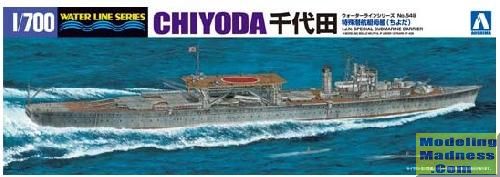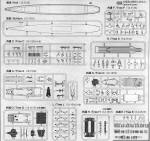
Aoshima 1/700 IJN Chiyoda 'Special Submarine Carrier'
| KIT #: | 001219 |
| PRICE: | $35.00 SRP |
| DECALS: | One option |
| REVIEWER: | Scott Van Aken |
| NOTES: | Modified reissue |

| HISTORY |
Chiyoda was laid down on 26 November 1934 and launched on 29 November 1936 at Kure Naval Arsenal and was commissioned on 25 July 1938. On completion, she was assigned directly to the Combined Fleet under the command of Captain Tomeo Kaku and was dispatched to the front lines in the Second Sino-Japanese War paired with the seaplane tender Kamoi. She remained engaged in combat operations in China until May 1940. On returning to Kure Naval Arsenal on 23 May 1940, Chiyoda underwent her first major modification, with her aircraft capacity reduced from 24 to 12 aircraft, and the space used to store 12 Type A Kō-hyōteki-class submarines. This rebuild was completed on 23 June, and Chiyoda was assigned to the IJN 4th Fleet based at Truk in September. Captain Kaku Harada was appointed captain in August. Chiyoda returned to participate in a naval review held on 11 October in Yokohama to celebrate the 2600th anniversary of the founding of the Japanese Empire. Afterwards, she was reassigned back to the Combined Fleet and began training operations on the use of her midget submarines through September, developing tactics for attacking other vessels (using Chitose as a target) and penetrating enemy naval bases. At the time of the attack on Pearl Harbor, Chiyoda was docked at Kure and continued training operations to 20 March 1942, when she was assigned to Vice Admiral Teruhisa Komatsuís IJN 6th Fleet together with the submarine tender Nisshin and the Aikoku Maru.
During the Battle of Midway, Chiyoda was part of Main Body of the Japanese fleet. For this operation, she carried eight Type A Kō-hyōteki-class submarines, which were intended to be stationed at Kure Atoll, which was to be seized as a seaplane base for operations against Midway Atoll. The operation was cancelled on the loss of the Japanese aircraft carriers during the Battle of Midway, and Chiyoda returned to Hashirajima with her submarines on 14 June without having seen combat.
During June, Chiyoda was refit for operations in northern waters, and departed Yokosuka Naval District on 28 June, arriving at Japanese-occupied Kiska in the Aleutian islands on 5 July with a construction team to build a seaplane base. She was attacked by aircraft from the USAAF 11th Air Force on the same day, without damage and arrived back at Hashirajima on 19 July.
On 25 September, Chiyoda was reassigned to the Guadalcanal area in the Solomon Islands and delivered eight Type A Kō-hyōteki-class submarines to Shortland Island on 14 October. She was attacked by Allied aircraft on 29 October and 31 October, but suffered no damage, and on 6 November, after her return to Truk, she was attacked by USS Grayling (SS-209), which fired three torpedoes at Chiyoda, all of which missed.Chiyoda returned to Yokosuka on 8 January 1943 and was converted from a seaplane tender to a light aircraft carrier at the Yokosuka Naval Arsenal beginning 16 January, with the work completed on 21 December 1943.
| THE KIT |
 Back when the waterline series first came out (which would be the late 1960s for many of you), four companies were producing ships; Aoshima, Tamiya, Fujimi and Hasegawa. To be honest with you, of those older releases, Aoshima's were not the top choice. However, as each manufacturer chose a certain line of ships to produce, if you wanted a specific ship, you had to pick what that company produced. Things have changed a great deal over the intervening decades and Aoshima now produces some the best quality kits on the market.
Back when the waterline series first came out (which would be the late 1960s for many of you), four companies were producing ships; Aoshima, Tamiya, Fujimi and Hasegawa. To be honest with you, of those older releases, Aoshima's were not the top choice. However, as each manufacturer chose a certain line of ships to produce, if you wanted a specific ship, you had to pick what that company produced. Things have changed a great deal over the intervening decades and Aoshima now produces some the best quality kits on the market. Instructions are well done with the usual Gunze paint references. The ship is basically dark grey with many of the deck areas being wood. There are two decal sheets. One with flags and the other with the big red Hinomaru for the upper deck and smaller ones on a white background for the submarines.
| CONCLUSIONS |
I have to say that this is a pretty neat kit. It provides a variant of this ship I've not yet seen kitted. I know that there is aftermarket for the Chitose that should be relevant for this ship as well as they were quite similar. Regardless of how you build this one it will be a nice addition to any IJN waterline collection.
| REFERENCES |
https://en.wikipedia.org/wiki/Japanese_aircraft_carrier_Chiyoda September 2015
Thanks to www.dragonmodelsusa.com for the preview kit. You can find this kit at your favorite hobby shop or on-line retailer. If you would like your product reviewed fairly and fairly quickly, please contactthe editor or see other details in the